Research Article
Comparative Study between Primigravida and Multigravida Regarding Women's Self-Care Practices for Management of Selected Minor Discomforts
1Lecturer of Obstetric Nursing, Faculty of Nursing, Menofia University, Egypt
2Assistant professor of Obstetric Nursing, Faculty of Nursing, Menofia University, Egypt
*Corresponding author: Gamila G Ayoub, Lecturer of Obstetric Nursing, Menofia University, Departments of Nursing, Egypt, E-mail: gigi.ayoub@yahoo.com
Received: June 28, 2018 Accepted: July 11, 2018 Published: July 17, 2018
Citation: Ayoub GG, Awed HA. Comparative Study between Primigravida and Multigravida regarding Women's Self-Care Practices for Management of Selected Minor Discomforts. Madridge J Case Rep Stud. 2018; 2(1): 41-49. doi: 10.18689/mjcrs-1000111
Copyright: © 2018 The Author(s). This work is licensed under a Creative Commons Attribution 4.0 International License, which permits unrestricted use, distribution, and reproduction in any medium, provided the original work is properly cited.
Abstract
Self-care means a person's ability to undertake self-care requisites or needs for preserving health and well-being. During pregnancy, the rapidly rising hormones change the maternal body and may cause some symptoms in the mother called as minor disorders. Aim of this study was to compare between primigravida and multigravida regarding women's self-care practices for management of selected minor discomfort. Research Design for this study was correlational descriptive. Setting of this study was conducted in the keebly MCH at Menofya governorate in Egypt. Subjects and methods: convenient sample was used to collect data in a period of six months, two days / week (Monday and Wednesday) and started from March 2016, until August 2016, and the total number was 300 pregnant women for three trimesters (90 primigravida and 210 multigravida), two tools for data collection was structured first; interviewing questionnaire sheet, and second; minor discomforts assessment sheet. Results of the study revealed that (33.3%) of the primigavida had moderate education compared to (21.4%) among multigravida. Less than half of the primigravida (42.9%) attempts to manage nausea and vomiting by avoid food smelling compared to (26.3%) among multigravida. Additionally, more than half of both groups (55.3%primi, 54.1% multi) avoid fried, spicy, and fatty food as a one method to manage their heartburn. Relatively two thirds (65.5%) of the primigravida avoid standing for long time for managing back pain compared to (46.1 %) among multigravida.
Conclusion: There was no significant difference between primigravida and multigravida women's self-care practices for management of (constipation, heartburn, backache, and leucorrhea). Recommendations: Establishing educational program for all pregnant women's about minor discomforts & its correct self-care practices intended for increasing their knowledge.
Keywords: Minor discomforts; Self-care practice; Pregnant women.
Introduction
Pregnancy is a joyful and excited period in the woman's life with bringing a new life into the world, requires a distinctive care from the time of conception to the postnatal stage. Moreover, pregnancy accompanied with radical changes in the women's body leads to many discomforts called “minor disorders or ailments of pregnancy”. These minor disorders may occur due to hormonal, accommodation, metabolic and postural changes. Most of these disorders are not dangerous; just a normal part of pregnancy, and can be managed at home. Common ailments of pregnancy at first trimester include nausea, vomiting, fatigue and frequency of micturition. In second trimester, heart burn, constipation, vaginal discharge and back ache. At third trimester includes hemorrhoids, leg cramps, edema, and insomnia [1,2].
Approximately 50%–80% of women experience nausea and vomiting in early pregnancy (NVP), that is, in the first and early second trimesters. Symptoms are resolve by 16-20 weeks. NVP may be considered as emesis gravidarum, which is mild, or hyper emesis gravidarum, which requires treatment or even hospitalization. The exact cause is unknown but there are some predisposing factors such as; levels of human chorionic gonadotropin (HCG), levels of estrogen and progesterone, placental prostaglandins, serotonin levels, thyroid dysfunction, increased leptin levels, immune system dysregulation, Helicobacter pylori infection, and gastrointestinal dysmotility [3,4].
Some self-care practices by women who have NVP include actions to either relieve or stop it through: lifestyles modification, dietary modifications such as; avoidance of large meals and consumption of low-fat, low-fiber, bland foods (e.g., breads, crackers, cereals, eggs, tofu, lean meat, peanut butter, fruits, vegetables), avoidance of foods with strong smells and those with increased protein and liquid content is often recommended, drugs and other alternative therapies used [5].
Constipation is one from a common symptom experienced during pregnancy. This can result from multi factorial, including changes in hormones during pregnancy affecting the digestive system, reduced physical activity and changes in dietary habits during pregnancy. It has a range of consequences from reduced quality of life and perception of physical health to hemorrhoids. An understanding of the effectiveness and safety of treatments for constipation in pregnancy is important for managing pregnant women. Generally, nonpharmacological interventions (increase roughage in diet, drink at least six to eight glasses of water per day, maintain regular schedule for bowel movements, use relaxation techniques such as deep breathing, and moderate exercises) are recommended initially, followed by pharmacological interventions if the non-pharmacological interventions fail or are insufficient. Pharmacological interventions include medications from a wide range of drug classes including lubricants, bulk-forming agents, osmotic laxatives, stimulant laxatives, stool softeners, and enemas and suppositories [6].
Heartburn is a sensation of burning in the upper part of the digestive tract including the throat. It is one of the most common gastrointestinal symptoms in pregnant affecting more than two-thirds of women and it can happen anytime during pregnancy. It is produced by pregnancy hormones affecting the muscle that keeps food in the stomach, and letting acid in the stomach come back up the throat. The symptoms may be frequent, severe and distressing, but serious complications are rare. Many interventions have been suggested. Lifestyle adjustments are recommended for treating mild symptoms. Women are often advised to eat smaller meals, chew gum, not to eat late at night, to elevate the head of the bed and avoid foods and medications that cause heartburn. For more troubling reflux symptoms, medications are sometimes used such as antacids [7].
Frequency of micturition is alternative bothersome symptom during pregnancy that means needing to urinate more often than usual. Urgent urination is a sudden, strong urge to urinate, along with discomfort in bladder. The enlarging gravid uterus early in pregnancy applies pressure on the bladder base causing frequent urination. Most women experience an increased urge to urinate during pregnancy. This is a normal body response related to hormone changes that occur during pregnancy and physical pressure on the bladder. Self-care measures for managing it through empty bladder regularly; perform kegel exercises; limit fluid intake before bed time; wear perineal pad; report pain or burning sensation to primary health care provider [8].
Low back pain (LBP) during pregnancy is defined as recurrent or continuous pain around the lumbar spine that lasts for more than 1 week. Prevalence estimates suggest between 45 and 75% of women experience LBP at some stage during their pregnancy and up to 70% of women experience pelvic girdle pain (PGP) by late pregnancy. The etiology of LBP is unclear and probably multi factorial such as altered posture during pregnancy, ligamentous laxity, and fluid retention within connective tissues. Majority of women obtain little or no treatment from healthcare providers for lumbopelvic pain in pregnancy. There are various types of applications for the treatment of low back pain during pregnancy. However, there is a lack of evidence for the effectiveness of each method. If there is not an obvious deficit, bed rest, exercise, conventional physiotherapy, using protective principles for the lumbar area are recommended [9,10].
Leucorrhea means increased thick, white vaginal discharge due to high levels of estrogen in pregnancy result in marked shedding of superficial mucosal cells in the vagina. Approximately, 75% women experience leucorrhea in their lives. Leucorrhoea is one of the major burdens of diseases in developing countries, including infections caused by any combination of physiologic and pathologic factors. With the higher levels of estrogen, the normal bacteria (lactobacillus acidophilus) in the vagina increase activity, lactic acid byproducts, and vaginal acidity, which provide some protection against pathogens. Leucorrhoea not preventable and does not induced infection automatically. Fortunately there are some simple measures can be used dealing with it such as; by maintaining good hygiene, do not douching, wear perineal pads, report to primary health care provider if accompanied by pruritis, foul odor, or change in character or color [11,12].
Insomnia during pregnancy can be accompanying with hormonal and mechanical changes in pregnancy. Up to 90% of pregnant women report disturbed sleep. For some women, severe sleep disturbance and sleeping <6 hours per night, has been accompanying with an increased risk of longer labors, caesarean birth [13].
Interventions to reduce disruption of sleeping during pregnancy include: forming sleep/wake habits and modifying sleep environment, avoiding caffeine and passive smoking, relaxation techniques, massage, heat and support for lower back pain, limiting fluids in the evening [12].
Significant of the study
Self-care is the development and use of personal health practices and coping skills for promoting their own health, preventing or limiting disease, and maintains wellbeing. These activities are usually undertaken without professional assistance [14].
Limited research are accessible in Egypt that reports on the self-care practices used amongst antenatal women's to alleviate their minor discomforts during pregnancy. Unfortunately, most of the published international studies emphasis on knowledge rather than practices. There is a need to assess the scale of this phenomenon as one base for the midwifery nurse for establishing her future education in our society. Thus, it is important to compare woman's self-care practice between primigravida and multigravida of the common minor disorders and their management. Midwives and nurses should question the strategies used by pregnant women. In this way, the inappropriate and incorrect practices can be determined, and education on the appropriate practices can be provided.
2. Aim of the study
To compare between primigravida and multigravida regarding women's self-care practices for management of selected minor discomfort.
3. Research questions:
1-Are the women's self-care practices to relive minor discomforts correct?
2-What is the difference between primigravida and multigravida regarding women's self-care practice for management of selected minor discomforts during pregnancy?
4. Subject and Methods
4.1. Research Design
Correlational descriptive was used in this study
4.2. Setting
The data was collected from keebly maternal and child health (MCH) center at Menofya governorate in Egypt.
4.3. Sample
The studied subjects represented a convenient sample of 300 of pregnant women (90 primigravida, 210 multigravida). The studies Participants recruited according the following criteria:
1. Not diagnosed with chronic disease for example: diabetes, anemia, and hypertension.
2. Not previously categorized into high risk pregnancy.
4.4. Tools of Data collection:
Two tools developed by the researcher to collect the required data. All sheets were designed by the researchers; the first tool is:
I-An Interviewing Questionnaire it included the following:
A- Socio-demographic data sheet:
-This sheet includes socio-demographic data of the pregnant women such as age, level of education, occupation and marital status and type of family.
B- Past and Present Obstetric History:
-The questionnaire determine numbers of gravida, number of abortion, numbers of para, present gestational age, follow-up of the current pregnancy, place of follow-up, time for initiation of follow-up.
II-The second tool used is called Minor Discomforts
Assessment Sheet
This sheet was divided two parts:
1-First part to assess women's complaining of selected minor discomforts.
2- Second part used to assess women's self-management practiced toward selected minor discomfort that can be faced during her pregnancy.
4.5. Validity test
Validity test was done by three experts' of faculties' staff nursing from the obstetric specialist to test content validity of the study tools.
4.6. Reliability test
Reliability test was done by applying the questionnaire to 30 women using test- retest and Pearson Coefficient factor was 90.8%.the scale was applied on them and retested after two weeks. The degree of spearman's rank coefficient test was
4.7. Operational Design
4.7.1. Ethical consideration:
Permission to conduct the study will be obtained from the dean of the Faculty and administrator of MCH center. Verbal consent will be obtained from each participant. The researcher will offer adequate information about the study purposes and its significance. Participation is voluntary. Participants will be assured that their responses would be confidential and information that might reveal their identity would not be recorded, and only aggregated data would be communicated.
4.7.2. Pilot Study:
A pilot study was implemented on thirty (10%) pregnant women from keely MCH center to test the applicability of the tools and to estimate the time needed. On the basis of the pilot study result the researcher determined the feasibility of data collection procedures, developed an interview schedule, and identified the most suitable time to visit subjects. The results of the pilot study helped in refining the interview questionnaire, and to set the final schedule, some modifications were done because of the length of the sheet as it took long time and effort.
4.7.3. Field work
4.7.5. Statistical Design
Data were revised, coded, tabulated and analyzed using numbers and percentage distribution and carried out in a computer SPSS program. Version (16.0) was used for that purpose. The following statistical techniques were used: Percentage and Qi-Square.
Significance of the Results:
When p > 0.05 it is statistically insignificant difference.
When p < 0.05 it is statistically significant difference.
Results
Table (1) indicated more than two thirds (72.2%) of the primigravida were in age group ranged from (20-29) years old compared to (47.6%) among multigravida and only (5.6%) of primigavida their age above 34 years compared to (17.6%) among multigravida with mean age of the primigavida was (24.1139+5.10904) compared to (29.6879+74224) among multigravida. Majority (94.4%) of multigravida were married compared to (98.1 %) among primigravida and only (4.4%) were widow among primigavida compared to (1%) among multigravida was widow. Relatively more than one third of primigravida (34.2%) had moderate educational level compared to (29.8%) in multigravida; and only (5.1%) of primigravida had illiterate educational level compared to (17%) among multigravida mothers. Most of primigravida (86.1%) were housewives compared to (83%) among multigravida mothers and only (2.8%) of mltigravida were farmer compared to no one among primigravida mothers. In addition, it was found that (72.2%) of primigravida had small family that means their families consist of (wife, husband only) compared to (2.8%) among multigravida and (6.4%) of multigavida had large family that means their families consist of (wife, husband, children & grandmother) compared to no one among primigravida mothers.
As shown in table (2) shows the majority of the primigavida (98.9%) were had not any previous history of abortion compared to more than two thirds (75.2%) of the multigravida. while only (1.1%) of the primigavida were had previous history of one time abortion compared to (18.1%) among multigravida with highly significant differences between both groups regarding to abortion (X2=24.1, P=0.000). Regarding to parity there were highly significant differences between both groups (X2=113.5, P=0.000). More than one third of the multigavida (48.6%) their previous history of delivery ranged from two to three times and (2.4%) of them delivered more than 4 times. Concerning to gestational age (40%) of the primigravida their gestational age involved in first trimester compared to (49.5%) among multigravida with (X2=3.3, P=0.07) so there were no significant difference between both groups regarding to gestational age. About to place of follow up majority of primigravida (66.7%) were follow up their pregnancy in MCH centers compared to (71%) among multigravida and (23.3%) of primigravida follow-up their pregnancy with private doctor compared to (10%) among multigravida with (X2= 4.5, P=0.03 Sig.) There were no significant differences between both groups regarding to time for initiation of their follow-up (X2=3.0, P=0.08 NS); more than two thirds of both groups (73.3%, 73.8% retrospectively) among primigravida and multigravida initiate their follow – up during pregnancy during first trimester however (12.2%) among primigarvida initiate their follow –up during third trimester compared to (6.2%) among multigravida.
Regarding Comparison between primigravida and multigravida women's regarding their presence of selected minor discomforts, it was found from figures (1) that more than half (54.4%) of the primigavida women had vomiting during the current pregnancy compared to (62.2%) among multigravida. Furthermore, three quarters of the primigravida (60%) complained from frequency of micturition compared to (77%) among multigravida. 31.1% of primigravida had constipation during their current pregnancy compared to (33.8%) among multigravida. In according to heartburn more than half (52.2%) of the primigravida had heartburn compared to less than half (40.5%) of the multigravida and more than three quarters (61.1%) of primigravida had back pain compared to two quarters (41.4%) among multigravida. Majority (87.8%) of primigravida had leucorrhea compared to (19.1%) between multigravida. Finally, (84.8%) of primigavida had sleeping disturbances compared to (83%) among multigravida.
Table (3) presents number and percentage distribution of the studied sample according to their self-care practices in relation to management of nausea and vomiting which revealed that more than half (54.4 %) of primigravida were suffer from nausea and vomiting compared to (65.2%) among multigravida. From them less than half (42.9%) of primigravida did avoid food smelling as a method for managing their nausea and vomiting compared to (26.3%) among multigravida, while (22.4%) of primigavida take dry crackers before arising from bed compared to 8% among multigavida and 10.2% of primigravida not perform any thing for managing nausea and vomiting compared (3.7%) multigravida.
Table (4) appearances number and percentage distribution of the studied sample according to their self-care practices in relation to management of constipation. About (31.1%) of primigravida did suffer from constipation compared to (33.8%) among multigravida. More than half (64.3%) of primigravida managed their constipation by increase roughage in the diet compared to (59.2%) among multigravida, while (17.6%) of primigravida managed their constipation by drink at least six glasses of water per day compared to (15.5%) between primigravida. There were no significant differences between both groups regarding to method used to relive constipation with (X2=0.13, P=0.71)
Table (5) displays number and percentage distribution of the studied sample according to their self-care practices in relation to management of heartburn. More than half (52.2%) of primigravida compared to (40.5%) of the multigravida. (55.3%) of primigavida avoid fried, spicy, and fatty food for managing heartburn during pregnancy compared to (54.1%) between multigravida, only (4.3%) of primigravida eat frequent, small meals compared to (1.2%) among multigravida managed of it with no significant differences between both groups regarding to their self-care practice for managing heartburn during pregnancy (X2=0.001, P=0.96).
Table (6) demonstrates the number and percentage distribution of the studied sample according to their self-care practices in relation to management of frequency of micturition. About (60%) of primigravida did suffer from frequency of micturition compared to (76.7%) among multigavida. (31.5%) of primigravida decrease amount of drinking tea and coffee for managing frequency of micturition compared to (19.3%) among multigravida, while (1.9%) of primigavida take medication as a self-care for managing frequency of micturition compared to (1.2%) among multigravida. There were no significant difference between both group related to women self-care for managing frequency of micturition (X2=0.56, P=0.45).
Table (7) illustrates number and percentage distribution of the studied sample according to their self-care practices in relation to management of back pain. Slightly less than one third of the primigravida (61.1%) did suffer from back pain compared to (41.4%) among multigravida. (65.5%) of the pimigravida avoid standing for long time for managing their back pain during pregnancy compared to (46%) among multigravida, while (5.5%) of primigravida avoid high heeled shoes for managing of it compared to (5.7%) among multigravida. there were no significant difference between both groups regarding woman's self-care for managing back pain (X2=0.45, P=0.32)
Table (8) indicates number and percentage distribution of the studied sample according to their self-care practices in relation to management of leucorrhea. Majority of the primigravida (87.8%) did suffer from leucorrhea compared to (84.8%) among multigravida. Besides (63.3%) of primigravida wearing cotton under wears compared to (55.1%) between multigravida, (3.8%) of the primigravida neglect to implement any self-care regarding to leucorrhea compared to (2.2%) among multigravida, there are no significant differences between both groups regarding to leucorrhea (X2=0.03, P=0.84).
Table (9) designates number and percentage distribution of the studied sample according to their self-care practices in relation to management of sleeping disturbance. Majority of both groups the primigravida (84.8%) and multigravida (83.3%) did suffer from sleeping disturbance. (67.1%) of the primigravida did take warm shower before sleeping compared to (53.1%) among multigravida, while (1.3%) of the primigravida not doing anything for managing sleep disturbances compared to (2.3%) among multigravida.
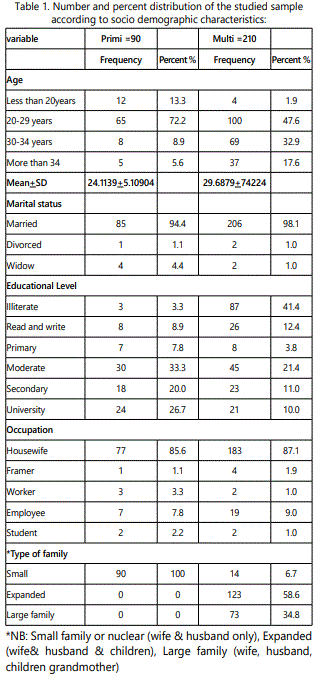
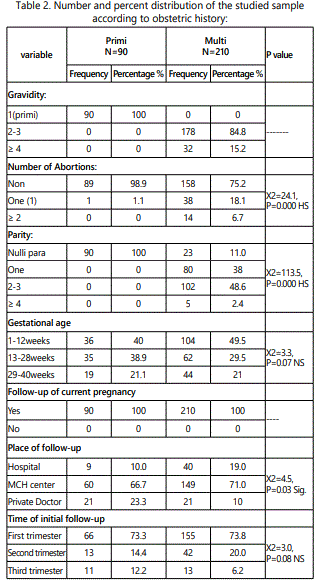
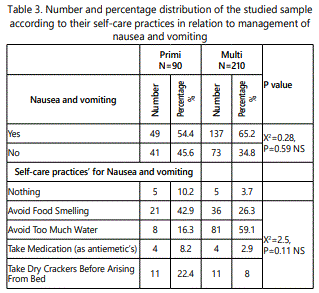
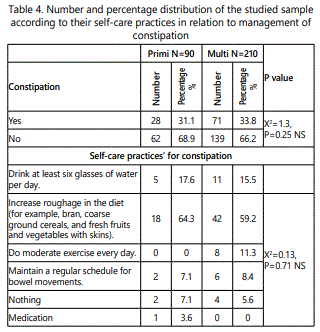
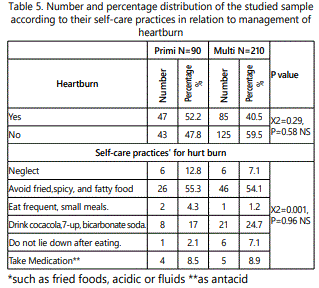
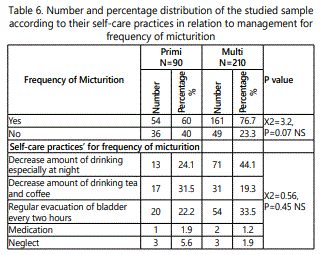
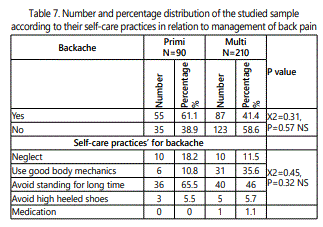
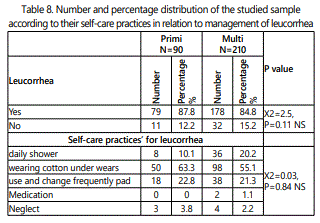
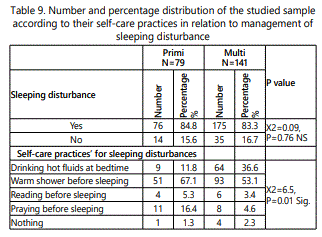
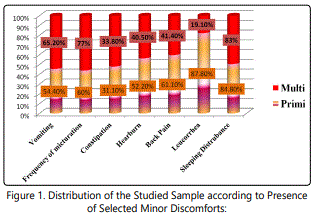
Discussion
Pregnancy is the normal incident in the life of a women body, every pregnancy is a unique experience for women and each pregnancy the women experience will be new and adequately different from the previous. The anatomical and physiological changes in pregnancy are associated with minor discomforts between women during pregnancy. Self-management regarding minor discomforts and practices during prenatal period is beneficial for pregnant women so practices of women about self-management are necessary for their health protection. [15]. In this context, the aim of this study is to compare between primigravida and multigravida regarding women's self-care practices for management of selected minor discomfort.
Regarding to socio-demographic characteristics' of the studied sample (table 1),
The result of present study revealed that; more than two thirds of the primigravida their age ranged between (20-29) years compared to less than half of multigravida. This age is considered as low risk pregnancy with expected to healthy outcome for their pregnancy. One third of the primigravida had moderate educational level as clarified by the present finding compared to less than one quarter in the multigravida. Finding of the present study also showed that, majority of the studied sample in both groups were married; that may reflect the responsibility toward their pregnancy outcomes can be sharing which lead to decreased psychological burden over them. Also, results of the present study disclosed that; most of the studied sample in both groups were housewives due to the fact that they had social affect because the difficulty to joining into work for moderate educational level. Finally findings of the present study discovered that all primigravida included in their nuclear family due to women want live alone rather than extended family; while most of multigravida included in extended family & this result are logical and reasonable due to their gravidity.
These study findings were supported by Delma et al., in India, they found that, majority of the antenatal mothers belonged to the age group of 21-25 years, house wives, belongs to nuclear family. Similar results held by Aziz K.F. and Maqsood S.S. who conducts their study in Erbil city who found that, the majority of the study sample was between 18-25 years old, secondary school graduates, housewives and nuclear families [16], [15].
As regards to presence of selected minor discomforts among primigravida and multigravida figures (1), current study exposed that; more than half of the primigavida complaining from nausea and vomiting during pregnancy (NVP) compared to more than two thirds among multigravida. This result agrees with Patil N., SalunkheJ. Perform study which showed that, most of the study sample experienced nausea and vomiting in early pregnancy [17].
Also Pluvio J. ET al. this result agrees with the prevalence of NVP in each trimester. The prevalence of nausea was 63.5 % in the first trimester, 33.8 % in the second and 26.2 % in the third. While, slightly more than one third of both primigavida and multigravida in the present study complaining from constipation during pregnancy [18].
Also, more than half of primigravida complaining from heartburn compared to less than half among multigravida's women. This study result agrees with Phupong V. & Hanprasertpong T. Reported that, the worldwide incidence of heartburn in pregnancy is 17% to 80%. [7].
Also, this is agreeing with the results of an exploratory descriptive study conducted by Khresheh 2011on 235 Jordanian pregnant women that, 91% of them were experiencing heartburn during pregnancy [19]. But this results slightly similar with study conducted in Jordan and in Brazil, which found that, heartburn occurred in 68.5% and 63% of the pregnant mothers [20].
Depending on the symptoms, the pregnant women either did nothing or took correct, incorrect or empirical actions to manage their problems. Data revealed that the major source of knowledge was based on their previous experience and that of close relatives. As their education level increased, the percentage of women taking scientifically proven action to correct the problem increased. Furthermore, two thirds of both groups of the studied sample suffering from frequency of micturition. This study result disagrees with a comparative and descriptive study conducted by Nazik E, determine the incidence of pregnancy-related discomforts and management approaches to relieve them among pregnant women in the obstetrics gynecology outpatient clinics of three hospitals in Erzurum, Turkey. It was found that, 79·9%, 88·4% of the pregnant women suffering from polyuria during second and third trimester [21].
However, more than two thirds of the primigravida women suffering from backache during pregnancy compared to less than half in multigravida. The same result described by Carvalho ME, et al. reported that, 68% the studied sample reported low back pain and of these 43.9% reported that low back pain began in the second trimester [22].
Also, more than two thirds of primigravida compared to less than three thirds of multigravidas' women were suffering from sleeping disturbance. This result in agree with Laucheet al. reported that 15.2 % of women experienced sleeping problems in their study participants [23].
Concerning to women's self-care practices for managing of nausea and vomiting (table 3) the present study stated that, less than half of the primigravida avoid food smelling as a one measure used for controlling nausea and vomiting during pregnancy compared to less than one third among multigravida. While more than half of multigravida avoids too much water as one method for controlling nausea and vomiting during pregnancy compared to less than one quarter in primigravida. Both groups of the studied sample perform correct practices related to manage their nausea and vomiting. This result agree with the result which was mentioned by Herrellin Johnson City, Tennessee who reported that, antenatal mother managed their nausea and vomiting during pregnancy by avoidance of foods with strong smells, dietary modifications such as avoidance of large meals and consumption of low-fat [4].
On the other hand, this finding slightly similar with Mahmoud et al. mentioned that, less than one third of the studied sample manage their nausea and vomiting during pregnancy by avoid some foods and drinks, while less than half of the studied sample (41.9%) eat dry foods at morning [24].
In relation to women's self-care practices for management of constipation (table4), the present study revealed, less more than two thirds of the primigravida try to manage it by increase roughage in their diet compared to more than half among the multigravida. Less than one quarter of both primigravida and multigravidas manage their constipation during pregnancy through drinks at least six glasses of water per day. Similar findings by Mahmoud et al. cited that, more than two thirds of the studied sample (78%) manage their constipation by increase some foods and fluid intake [24].
In relation to distribution of the studied sample according to their self-care practices to management of heartburn table (5). More than half of both the primigavida and multigravidiaavoid fried, spicy, and fatty food for managing heartburn during pregnancy which considers one of correct practice for dealing with heartburn during pregnancy. This result contradicting with study conducted by Mahmoud et al. reported that, less than half of the studied sample drink CocaCola, 7 up, bicarbonate soda for dealing with heartburn during pregnancy which is incorrect practice [24].
In the present study about less than one third of the primigravida who suffered from frequency of micturition did manage it by decrease amount of drinking tea and coffee compared to less than one quarter among multigravida, (table 6) as one correct women's practice. This result contradicting with Mahmoud et al. stated that, majority of the pregnant women (85.9%) perform frequent perineal care for dealing with that complain [24].
About women self-care for managing back pain table (7), the present study exposed that, less than two thirds of the primigravida who had suffered from backache did manage it by avoid standing for long time compared to less than half among multigravida as a correct practice for dealing with it. This study agrees with Mahmoud et al. described that, more than two thirds of the studied sample (65%) use good body mechanics for managing it [24].
Relating to women self-care for managing leucorrhea table (8), the present study disclosed that, less than two thirds of the studied sample did dealing with that complain by wearing cotton under wears compared to more than half of the multigravida as a correct practice. This result contradicting with Mahmoud et al. conveyed that, most of the studied sample (77.1%) performs perineal care for managing that complaint [24].
Finally concerning to sleeping disturbance (table 9) the present study illustrated that, more than two thirds of the primigarvida who complaining from insomnia (sleeping disturbances) taking warm shower before sleeping for managed that complaint compared to more than half of the multigravida. This present result similar with Mahmoud et al. mentioned that, more than one third of the studied sample (32.4%) taking warm bath for managing insomnia during pregnancy [24].
Conclusion
Based on the findings of the present study, it can be concluded that,
Pregnancy is a normal physiological and psychological process, however, sometimes it can be one of main dangers a woman faces in her life. Various physical symptoms were experienced by women in each trimester of pregnancy. Correct Self-care practice of the pregnant women is the first essential step for enjoying the pregnancy and its outcomes consequences. The findings of this study has provided an vision to comparing between primi and multi gravida women's self-care practices in the study area, which could help in designing suitable intrusions and as a base for further wide scale studies in other part of the country. So that, research questions of this study were answered. The majority of the women did not do anything to alleviate their physical symptoms.
Nursing care at the level of prevention focuses on helping women learn correct self-care practices. Most of the studied sample performs correct practices regarding o managing their selected minor discomforts in pregnancy reflect their awareness' regarding correct practices and antenatal educational classes which implemented inside the MCH centers. There was no significant difference between primigravida and multigravida women's self- care practice for management of some selected minor discomforts during pregnancy such as (constipation, heartburn, backache, and leucorrhea).
Recommended:
Based on the findings of the present study, the following recommendations are suggested:
1. Antenatal health education should consider the reinforcement, medication, or abolishment of pregnant women's traditional self-care practices according to their benefit versus harm.
2. Establishing educational program for all pregnant women's about minor discomforts & its correct self-care practice intended for increasing their knowledge through using health booklets, posters.
References